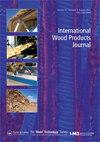Surface characterization and paint bonding quality on chemically and thermally modified short rotation teak wood
IF 0.9
Q2 MATERIALS SCIENCE, PAPER & WOOD
引用次数: 5
Abstract
ABSTRACT Chemical and thermal modification can change the hydrophilic properties of wood, and thus affect their coating performance. This study determined the surface characteristics of chemically and thermally modified short rotation teak wood. The characteristics studied were surface roughness, surface free energy (SFE), contact angle, wettability, and coating bonding quality. Results show that the surface of short rotation teak became smoother after chemical and thermal modifications; however, surface roughness increased after furfurylation. The total SFE of chemically and thermally modified teak wood decreased after treatment. The decrease in the total SFE caused the decrease in the constant contact angle change rate (K-value). The K-values for water-dispersed polyurethane and acrylic paints were nearly 0, which indicated their lower wettability. The paint bonding quality decreased after accelerated weathering. Short rotation teak with Glycerol-Maleic Anhydride (GMA)-thermal treatment can be considered for exterior applications with a proper selection of paint.化学和热改性短旋柚木的表面特性和油漆粘合质量
摘要化学和热改性会改变木材的亲水性,从而影响其涂层性能。本研究确定了化学和热改性短旋柚木的表面特性。研究的特性包括表面粗糙度、表面自由能、接触角、润湿性和涂层结合质量。结果表明,经过化学和热改性后,短旋柚木表面更加光滑;然而,表面粗糙度在糠化后增加。化学和热改性柚木的总SFE在处理后降低。总SFE的减小导致恒定接触角变化率(K值)的减小。水分散聚氨酯和丙烯酸涂料的K值接近0,这表明它们的润湿性较低。加速风化后,油漆结合质量下降。经过甘油马来酸酐(GMA)热处理的短旋柚木可以考虑在适当选择油漆的情况下用于外部应用。
本文章由计算机程序翻译,如有差异,请以英文原文为准。
求助全文
约1分钟内获得全文
求助全文
来源期刊

International Wood Products Journal
MATERIALS SCIENCE, PAPER & WOOD-
CiteScore
2.40
自引率
0.00%
发文量
27
 求助内容:
求助内容: 应助结果提醒方式:
应助结果提醒方式:


